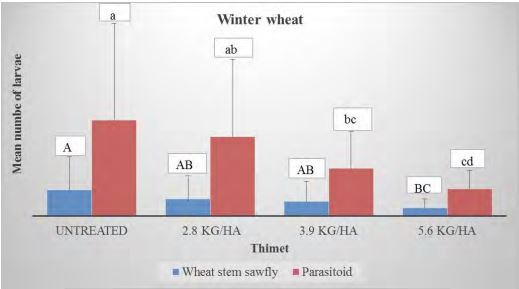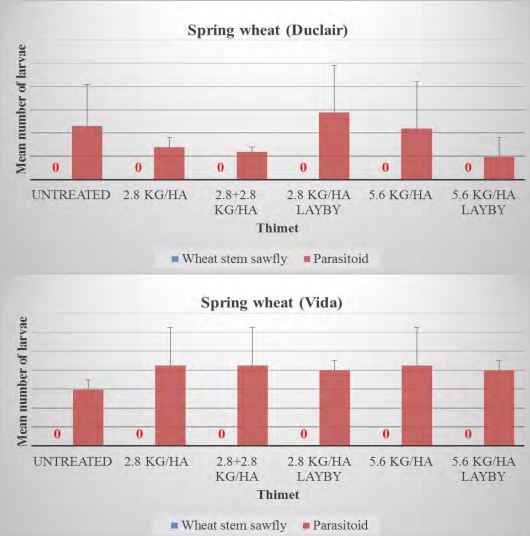Effect of Thimet against wheat stem sawfly, Cephus cinctus
Principal Investigator: Dr. Gadi V. P. Reddy Cooperators: John H. Miller, Amber Ferda, Julie Prewett
Introduction
The wheat stem sawfly (Cephus Cinctus) (Hymenoptera: Cephidae) is distributed across Montana, North Dakota, South Dakota, Wyoming, Idaho, Colorado, Alberta, Manitoba and Saskatchewan. This pest was first reported in Canada in the late 1800’s and has been increasing its range since that time (Knodel et. al. 2010). It was originally a wheatgrass dweller, but began its migration to small grains. It has become a serious pest for Montana, with estimated damages of $30 million a year on wheat production. The larval stage of the insect is the most damaging (Figure 1). The eggs are deposited inside the wheat stem, it grows to a larva, girdles the stem and plugs the top and remains in diapause until the following spring (Fullbright et. al. 2011).
-
Effect of Thimet on the survival of wheat stem sawfly on winter and spring wheat.
-
Effect of Thimet on the survival of parasitoid of wheat stem sawfly. Materials and methods
Field experiments were carried out to study the effects of Thimet 20-G against the C cinctus on the winter wheat variety, Yellowstone and spring wheat varieties, Duclair (solid stem) and, Vida, (hollow stem). Winter wheat application rates were applied as layby (between rows) treatments of 2.8, 3.9, and 5.5 kg/ha at Feeke’s growth stage 5. Six treatment rates were used for spring wheat. There were treatments applied at planting and as layby treatments when the spring wheat was at Feeke’s growth stage 2.2 (Table-1).
Thimet 20G was applied using a plot drill with Accupoint disk openers with individual cones for each opener. Statistics were done using a natural log transformation due to zero larvae in some wheat samples.
Wheat samples were collected prior to harvesting. Each sample was collected in one foot sections, twice, for a total of two feet. This was done for five locations. The samples were processed individually. Each individual stem was cut in half with a scalpel. The insects inside the stems were sorted into the following categories: live wheat stem sawfly and live parasitoid. They were counted and recorded.
Results
The winter wheat had live sawflies and live parasitoids and overall had many more larvae in the samples. Thimet 5.0 kg/ha significantly reduced population than other doses used (Figure-2).
There were no live wheat stem sawflies in the spring wheat samples (Figure-3), but there were live parasitoids.
The wheat plant samples were collected just before harvest it is very difficult to identify dead sawflies as they may be in late stages of decomposition. Overall, there were not as many larvae of any kind in the spring wheat as there was in the winter wheat.
The yield, test weight, and protein data are not reported in this poster as there were no significant differences due to treatment with Thimet 20G®. Part of that could be weather related as we had a fairly warm and quite dry summer, especially in June.
Table 1. Thimet® 20G rates applied to winter and spring wheat at planting and layby (between rows) with planting, treatment, harvest and sampling dates.
|
Treatment |
Rate Kg/ha1 |
Location |
Planting Date2 |
Harvest Date |
Sampling Date |
Treatment Date |
|
Winter Wheat Treatments |
||||||
|
Treatment 1 |
Untreated |
Devon |
10/6/14 |
7/23/15 |
7/23/15 |
5/19/15 |
|
Treatment 2 |
2.8 |
Choteau |
9/30/14 |
8/13/15 |
8/13/15 |
5/21/15 |
|
Treatment 3 |
3.9 |
Knees |
10/1/14 |
8/6/15 |
8/6/15 |
5/21/15 |
|
Treatment 4 |
5.6 |
|
|
|
|
|
|
Spring Wheat Treatments |
||||||
|
Treatment 1 |
Untreated |
Inabnit |
5/5/15 |
8/27/15 |
8/27/15 |
5/21/15, 6/8/15 |
|
Treatment 2 |
2.8 |
Killion |
5/5/15 |
8/6/15 |
8/6/15 |
5/21/15, 6/8/15 |
|
Treatment 3 |
2.8 plus 2.8 |
|
|
|
|
|
|
Treatment 4 |
0 plus 2.8 |
|
|
|
|
|
|
Treatment 5 |
5.6 |
|
|
|
|
|
|
Treatment 6 |
0 plus 5.6 |
|
|
|
|
|
1 For spring wheat treatments there is a planting date with treatments and some treatments are plus another treatment applied as a layby treatment. All winter wheat treatments are done as layby.
2 Winter wheat variety was Yellowstone and Spring wheat varieties were Duclair and Vida.
Figure-1. Life cycle of the wheat stem sawfly.
Figure-2: Effect of Thimet on wheat stem sawfly and its parasitoid on winter wheat.
Figure-3: Effect of Thimet on wheat stem sawfly and its parasitoid on spring wheat.
References
Fullbright, J., Wanner, K., Weaver, D. 2011. Wheat Stem Sawfly Biology. Montana State University Extension MontGuide, MT201107AG, 1-2.
Knodel, J., Shanower, T., Beauzay, P. 2010. Integrated Pest Management of Wheat Stem Sawfly in North Dakota. North Dakota State University Extension Service, E-1479.
Acknowledgements
Funding for this research is provided by Montana Wheat and Barley Committee and AMVAC Chemical Corporation.



